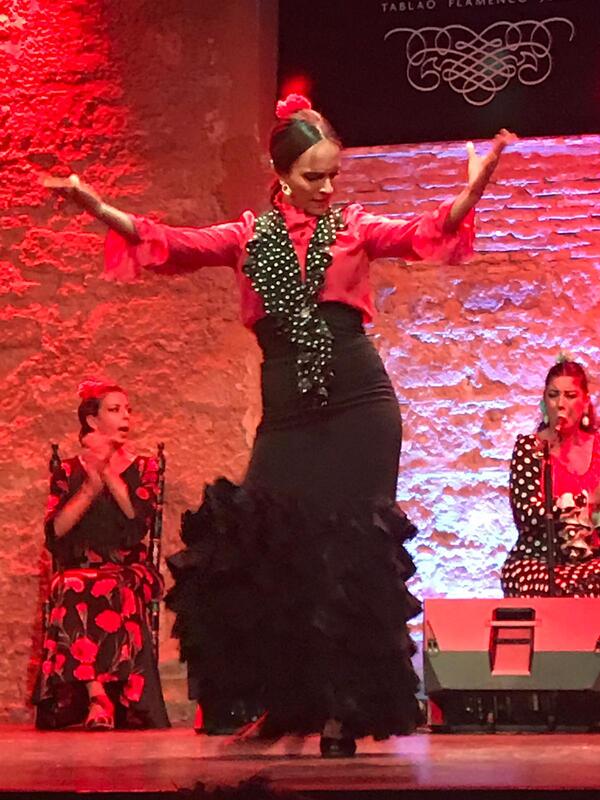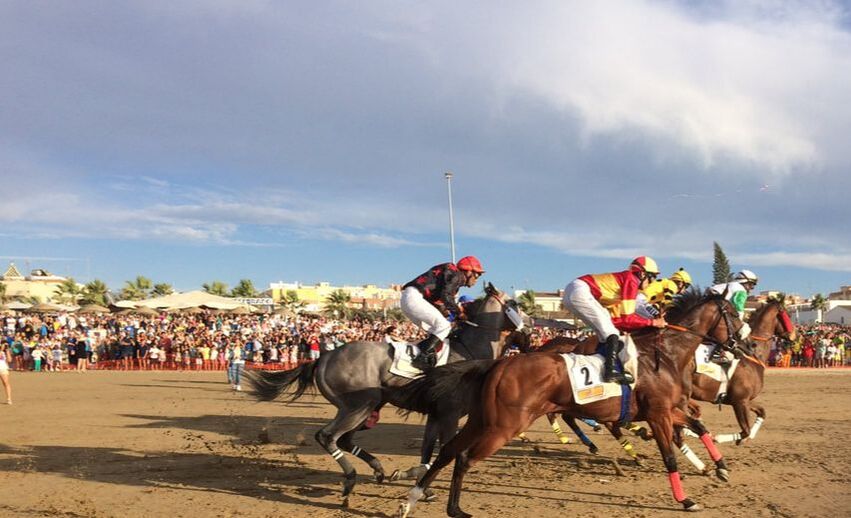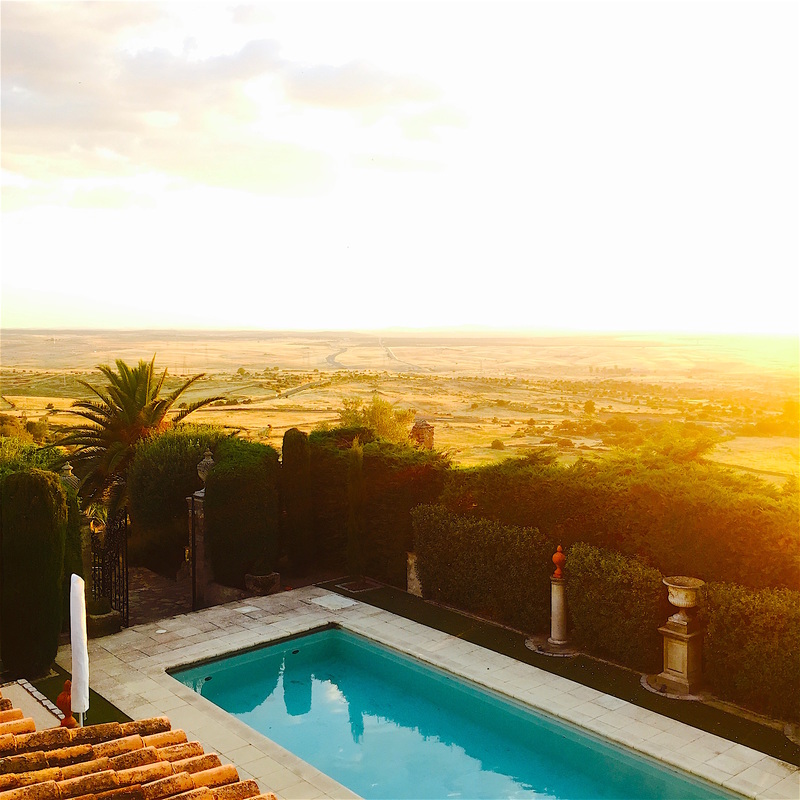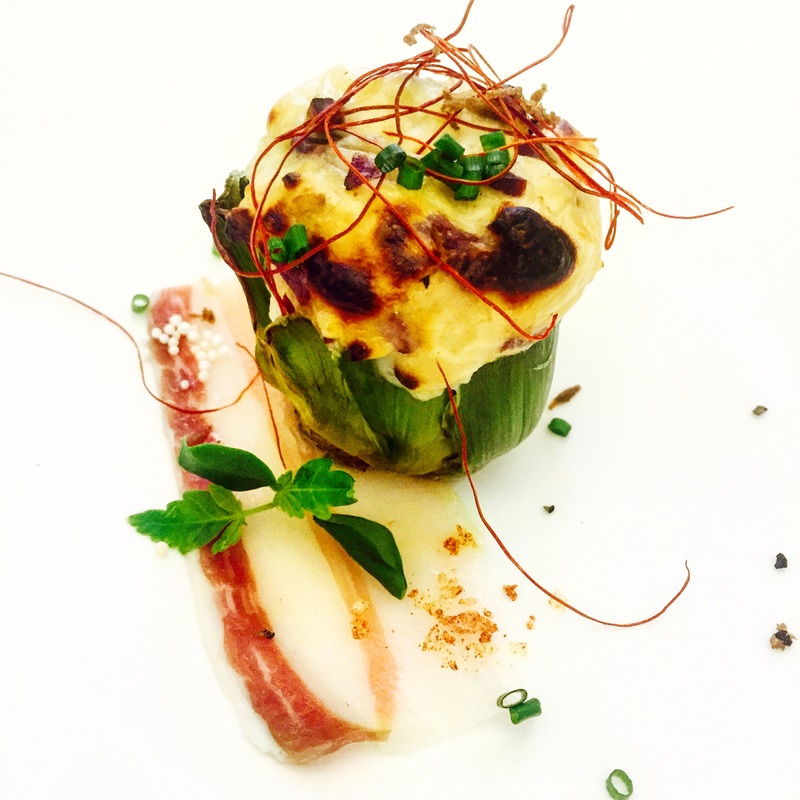|
I’ve always wanted to visit Cadiz, so when the Spanish Tourist Office asked us to visit this enchanting destination, I was thrilled to be given the opportunity to discover its charms first-hand. Cadiz forms a stunning part of Costa de la Luz, a section of the Andalusian coast line in south-west Spain known as the ‘Coast of Light’ given its year-round sunshine (more than 300 days), which provides the perfect opportunity for visitors to relax on the region’s 8km of beautiful beaches. Founded by the Phoenicians more than 3,000 years ago, this ancient port city with a population of just over 120,000, is one of the oldest cities in western Europe. Many of the historic buildings are made from oyster rock formed in the sea, a popular building material that can withstand Cadiz’s high humidity. The skyline is characterised by 129 watchtowers, built so merchants could see their ships arriving in the harbour. One of the most famous towers, Torre Tavira, with its Camera Obscura, is the ideal place to take in the city views. The old town of Cadiz with its stunning cathedrals and beautiful squares is the perfect size to wander aimlessly around, taking in the rich history of the buildings. Key highlights include Mina and Saint Antonio squares, The Botanical gardens and Ancha, renowned as the most beautiful street in Cadiz. Sherry, sherry and more sherry The Cadiz region is famous for its sherry, thanks to its soil (which contains a lot of calcium) and its climate (300 days of sunshine and plenty of rain), which combined provide the perfect growing conditions for the three grapes that are used to make sherry – Palomino, for dry sherry, and Pedro Ximenez and Moscatel for sweeter sherries. Where to enjoy sherry and traditional Spanish cuisine in Cadiz No visit to Cadiz is complete without a wine tasting at a traditional sherry bodega. We loved Bodegas Lustau (located just north of Jerez), one of the oldest wineries in Europe, and an ideal place to learn about everything you could ever want to know about sherry, including top tips such as serving it chilled paired with spicy food or mature cheese to bring out the best flavours. To continue our sherry appreciation, we enjoyed lunch at sherry bodega La Carbona, a traditional family-run restaurant offering regional dishes made with high quality ingredients, and of course, lots of sherry! With its high ceilings, wooden beams and terracotta tiles, it provides an air of cool sophistication in the heat of Jerez. Here diners can experience the culinary delicacies of the region from one of three menus (a tasting menu, a la carte or sherry pairing). We indulged in a five-course tasting menu, starting with a sherry-infused veal pate (a real taste bud tantaliser), followed by a light and delicious calamari and salmon risotto, which was bursting with flavour. Our favourite dish, however, was the divine duck with sherry and pears. But first, flamenco Andalusia is home to the birth of flamenco and with plenty of places in the region hosting flamenco shows, it’s a ‘must see’ experience. Typically, flamenco has four elements to it - hand-clapping, foot stomping, shouts of encouragement and what translates in English as ‘hell raising’. I had my first taste of flamenco at Puro Arte in Jerez. The show typically lasts 60 minutes and demands your FULL attention. The intensity was unlike anything I had seen before; I was immediately mesmerised by the energy, the passion, and the connection between the performers. If you’re seeking a traditional experience unlike any other, head to Sanlúcar de Barrameda to take in horse racing on the beach with a beautiful sunset serving as the backdrop for this spectacular race.
This racing tradition, which has been going for 175 years, was started by fisherman who used horses to help them be the first to get to the market. Today, thanks to big sponsors and a lucrative prize offering, this 1800-metre race attracts top quality horses and trainers from around the world. Hundreds of locals and visitors line the beach to watch the action, tucking into sunset picnics while the horses whizz past. Local children also get involved, betting sweets on their favourite horses to win! At the finish line, viewing platforms and VIP areas provide places to bet, see the horses and have a drink. The races generally start at 6pm – depending on the tide – and on average, there are four races per evening over three days twice a year in August. Horse fans should also ensure they visit the Royal Andalusian School of Equestrian Art, which hosts a programme of performances throughout the year by world renowned horses and riders. The verdict Whatever your pleasure, Cadiz provides a wealth of experiences for all to enjoy. From spectacular beaches to historical treasures, it’s a unique destination that should be on everyone’s Spanish travel bucket list. Elinor Seath *During my visit I was hosted by The Spanish Tourist Office, The Soho Boutique Hotel in Jerez, and La Carbona. All opinions and images are my own.
0 Comments
Arriving at Toledo in Spain’s Castilla La Mancha region, you may be forgiven for thinking you have dropped into a Hollywood movie set. On top of a steep hill, the majestic Alcazar on the left and the massive cathedral on the right are silhouetted against the sky.
Below, the historic city walls encircle the old town and at ground level, the languid waters of the Tajo River flow under several bridges. It’s no wonder then, that Toledo is one of the most popular tourist attractions in Spain.
If, like me, you arrive by AVE on the 30-minute train ride from Madrid, the magic starts already at the train station. The building is a little jewel of Mudejar architecture, a style combining Moorish and medieval elements in a colourful harmony. Many more fine examples are found in Toledo and several other cities in the southern part of Spain.
In 2014 the focus was on Toledo because it marked the 400th anniversary of the death of the great painter El Greco. He spent many years in Toledo where he created his best known masterpieces, many of them exhibited in the El Greco museum. This year, however, Toledo is in the spotlight again thanks to its food and drink. Spanish food is renowned for being rich and varied and every year, another city is designated as the Culinary Capital of the country with many events celebrating local dishes and creations.
If you have a sweet tooth, Toledo is the place for you because it’s famous for marzipan. Toledo’s main square is called Plaza de Zocodover and was a market place for cattle in the Middle Ages. Today it’s the meeting place where all activities start and the location of San Tome, the oldest confectionary and marzipan producer of the city.
In celebration of this year’s event, their trade mark is a marzipan cake decorated with a colourful eel. Eels used to live in abundance in the Tajo, but, sadly, not any more, but they live on in marzipan. The assistants in the shop are generous with samples, and you can try toledanas or a piece of marzipan fruit. If you don’t like sweets, Toledo spoils you with other specialties such as cheeses, ham, stews , quail in a variety of preparations, as well as tender lamb, all of which are to be found on the menu of countless restaurants.
During your visit, ensure you make your way to the Mercado San Agustin, not far from Plaza de Zocodovar. Here you'll find a modern market, with four floors with fruit and vegetable stalls as well as tapas bars where you can sample the very best of this typically Spanish snack. Hanging gardens with little waterfalls in between make it a market like no other.
Thankfully, you can eat without fear of putting on weight, as Toledo is a city best explored on foot. Uphill or downhill, you spend hours walking from one breathtaking sight to the next. Along Calle Ancha, you can see silversmiths making elaborate pieces of the world famous Toledo steel, once the standard weaponry of the Romans, which today lives on in decorative artefacts and jewellery. No visit to Toledo is complete without a visit to the cathedral. Afterwards, meander through the narrow streets of the Jewish quarter and finish your tour at the medieval bridge, Puente San Martin where you'll find the starting point of La Tirolina - the longest zip line in Europe. Once kitted out in safety gear, you fly over the river, where you can enjoy the magnificent view below.
After the zip line experience, I stopped by my favourite bar for a coffee, where the owner recommended that I 'talk to the people with the yellow umbrellas’ in Zodocover Square. The people he was referring to were tour guides from Cuentametoledo, a company that specialises in nightly underground tours of Toledo. I went on a tour from 10pm to midnight, visiting five magic sites including: Arab baths, Roman baths, and a well located deep under the Jewish quarter - all illuminated by magical fairy lights.
Whether you're above ground or below ground, Toledo is a feast for the senses, and a destination that's not to be missed on any visit to Spain.
For more information visit: http://www.spain.info http://flytoledo.com http://www.cuentametoledo.com Inka Piegsa–Quischotte Ready to book your holiday to Toledo? View the offers below from Booking.com... Spain’s Delicious SecretHere at Destination Delicious, gastronomy is undoubtedly at the top of our agenda when discovering new travel treats. While the beach barbecues of Antigua and the fine dining of Venice are clearly highlights of our recent travels, a quiet, dusty little corner of Spain left taste buds well and truly tickled with melt-in-the-mouth jamón, crisp wine and fantastic tapas. Love España but bored of Barcelona and not sold on the Costa del Sol? Head west from Madrid, on the road to Portgual and a few hours later you’ll find yourself amongst the stork-filled blue skies of Extremadura. We promise you won’t be disappointed. The tiny medieval town of Trujillo is a picture perfect Spanish bolthole. Perched atop a hill overlooking the dusty plains, this medieval enclave of cobbled streets, secretive labyrinthine stone villas and a population of less than 10,000 is almost soporific in its lazy, hazy charm. We defy you not to fall instantly in love with the place. One of the area’s most important and historic towns, Trujillo was the birthplace of Francisco Pizzaro, the famous Conquistador who travelled to the New World, conquered the Inca Empire and founded Lima in Peru; quite the achievement considering it was the 15th century. Much of the town’s magnificently preserved architecture is the result of his - and other Conquistadors’- return with new-found wealth, and to this day he still dominates the main square on horseback in the form of a bronze statue. With this kind of location lending itself to a holiday based around food, wine, sunshine and relaxation, the accommodation on offer from Trujillo Villas España is the exactly what the doctor ordered. Run by a family with historical roots in the town, each of its seven distinctive properties comes with a slice of authenticity that’s totally unrivalled. From the paintings on the living room walls, to the original tiled floors, every square inch of them is seeped in history, just waiting to unveil their stories. If, however, you’re travelling with a larger group, you’ll have the pick of the bunch. Situated right at the top of the town, the elegant private estate of Villa Martires and its accompanying Garden Cottage (which can be rented separately or together), presides over Trujillo’s skyline, with a tennis court overlooked by the castle battlements. With 180 degree views across the countryside towards Portugal and the Gredos mountains from its terraces, it comes with some of the most utterly breathtaking sunsets I’ve ever seen. An elegant gardenia-lined outdoor dining room offers the perfect setting in which to sample some local produce; Trujillo Villas España can arrange for the delivery of a delicious, freshly-cooked lunch to the villa featuring local specialities such as gazpacho, roasted red pepper salad with sweet paprika, local sausages in onion and sherry sauce and - of course - the Iberico jamon de Bellota. Trust us, you won’t want to miss it. With a Roman-style pool, open air Moroccan-style sitting room and beds of lavender, it’s a world away from the Spain we’ve known before - in the best possible way. This is the real deal; prepare to fall head over heels. Trujillo itself offers visitors plentiful opportunities for soaking up the history of this fascinating region with beautiful architecture galore, but it’s the food that’s the real star attraction here. Make your way downhill to the town once the sun starts to set and you’ll be greeted with a main square - the Plaza Mayor - that comes alive after dark, full of family-run establishments serving traditionally rustic, local cuisine. For terrific tapas try Cervezeria Plaza Mayor on the square; don’t miss the croquetas with jamon iberico (croquettes), prueba (pork stew) and migas (traditional savoury breadcrumbs). Nestled in the corner of the square, the Corral del Rey restaurant offers a sterling three course set menu, including a glass of wine, for €25. With dishes on offer including garlic-drenched prawns, local Iberian pork seasoned with paprika and chocolate covered figs, it’s a must-visit. Dinner isn’t Trujillo’s only foodie attraction; April 29th-May 2nd will see the Plaza Mayor take a more pungent turn as La Feria del Queso - the Trujillo cheese festival - arrives. Now in it’s 29th year, the event is - somewhat incredibly - the largest cheese fair in the world and turns the square into a cheese village. With hundreds of stands and over 400 variations of cheese, it attracts thousands of visitors every year - if your nose can cope, Trujillo Villas España’s Villa Piedras Albas, a labyrinthine 16th century palacio, next to the Corral del Rey, features a magnificent arched terrace overlooking the Plaza Mayor. While we can absolutely appreciate that one’s visit to Trujillo may not extend too far past the villa walls (NB: Trujillo Villa España can also have your food shop ready for when you arrive, but if not there are shops down in the main square for groceries and essentials) it would be a shame not to embrace the surrounding gastronomic opportunities. For those baptised in the ways of the grape, you simply must visit local vineyard Bodega Habla. Only established in 2000, Habla produces strictly limited edition runs of its wines, each of which comes with a fascinating story of how it was lovingly created after a number of years trialling which grapes would work in the difficultly acidic, slate-filled, Extremaduran soil. The stunningly chic minimalist branding is akin to an haute couture fashion house and what’s inside the bottles doesn’t disappoint. While a number of past wines are now sold out, we went home with a bottle of the refreshingly crisp Habla de Ti, a dry white sauvignon blanc. Ever the hostess with the mostest, Trujillo Villas España can arrange a guided tour of the vineyard for guests of their villas. The other not-to-be-missed foodie opportunity has to be a bespoke guided tour of Casa Bautista in Montanchez, a curing house for the region’s famous jamón Iberica de bellota, which can also be arranged by your villa hosts. These lucky swines live a life of riley, nibbling acorns across Extremadura’s oak-scattered pastures, before being retired to the slaughterhouse after they’ve reached maturity. After slaughter, the 18-month curing journey begins, with each and every leg closely monitored to ensure it’s matured to the perfect sweet, nutty, floral, earthy flavour that makes this jamón the most mouth-wateringly delicious in the world. It may be be slightly further afield - 45km, or a 30 minute drive from Trujillo - but if you take one day trip excursion make it a visit to nearby Caçeres. Voted Spain’s Capital of Gastronomy last year, it’s easy to see why. The two Michelin starred restaurant Atrio, in the Plaza San Mateo not only boasts incredible cuisine, but their wine cellar is unrivalled. We were granted an audience with the sommelier (previously of The Ritz in Paris) who showed off the nothing short of incredible collection of over 34,000 bottles, housed beneath stairs in the temperature and humidity controlled cellar. Suffice to say it is probably the only time one shall witness wines dating from as far back as Napoleonic times - astonishingly, the oldest bottle in situ dated from 1806. With only three bottles left in the world, the last known sale was at Christie’s in 2001 where it went for a cool €300,000. Best be careful with that one… While we can’t claim to have eaten at Atrio, nearby La Cacharrería (bookings - lacacharreria@live.com) must certainly give it a run for its money. Part tapas bar, part restaurant, part cabinet of curiosities, this fascinating little world lies through a wrought-iron gated courtyard on a sun-drenched side street; if you can tear your eyes away from the cases of butterflies, statues of the Virgin Mary and cupboards full of knick knacks (all of which are available to buy - I nearly left with a pair of horn candlesticks until remembering we had hand-luggage only…) the food is an absolute dream. Tastebuds were wowed with gems from their kitchen including a grilled sardine with gazpacho and wild garlic, local black pudding gyoza, artichoke hearts filled with béchamel sauce, local ham, mushrooms and saffron, a first-season fig with basil, goat’s cheese foam and melon and a succulent piece of co accompanied with bitter orange marmalade, scrambled egg and spinach, wrapped in a filo parcel. The piece de resistance was a display of fruit sushi - or frushi, if you will; sushi rice ensconcing chunks of melon, with watermelon nigiri and wasabi chocolate truffles. Genius. We could sit here for hours telling you of the glory of this sun-drenched corner of Spain, with its church-heavy towns, its rich culinary landscape and its breathtaking beauty, relatively untouched by modern tourism, but the best way for you to discover it is to book a visit for yourself.
With the sun in full shine from now it’s the perfect time for a getaway. Whether you’re in the market for a self-catering break with the family, a base to explore the region or one of Trujillo Villas España’s organised art, cookery or yoga breaks (full details on the website), we promise you this is one place you’ll want to come back to time and time again. If you don’t fall in love with it, you’re lying to yourself. Trujillo Villas España rentals from £595 per week. For full details, information on Trujillo and bookings visit www.trujillovillasespana.com. Laurel Waldron |
SpainWe've rounded our favourite places to inspire your visit to Spain. Archives
September 2019
Categories
All
|































 RSS Feed
RSS Feed